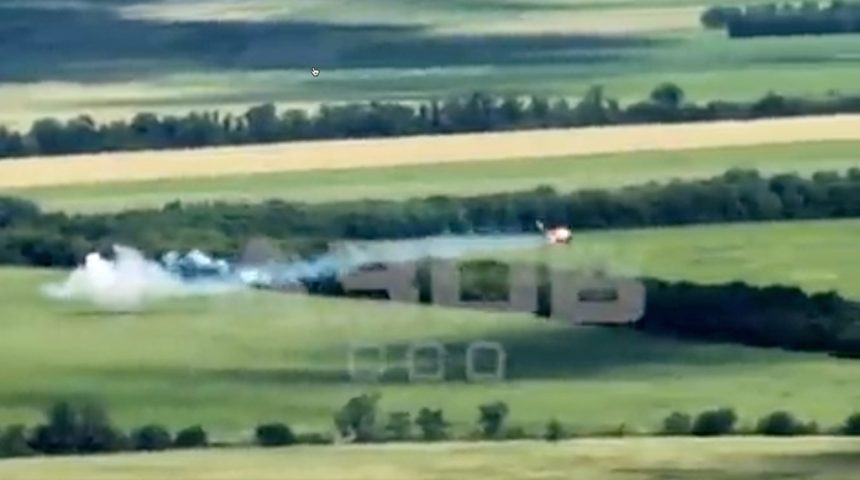The clip is a reminder that low-flying Russian helicopters are vulnerable to MANPADS (and ATGMs) in Ukraine.
A video, showing a Russian Mi-35M gunship helicopter shot down by an unspecified Ukrainian missile, possibly one fired by a MANPADS (Man-Portable Air Defense System), has started circulating online on Jun. 16, 2022.
The footage, that appears to have been recorded by a drone, shows the Russian helicopter flying at ultra-low level over the fields until it gets hit in the engine exhaust area (at the base of the main rotor), starts to spin and crashes into the ground.
#Ukraine: Excellent footage of this Russian Mi-35M taken down today by a MANPADS at very low level.
Conflicting locations & missile ID are given by different sources: either way this is among the most clear shootdown footage yet & shows the danger that wide MANPADS usage poses. https://t.co/8m4e7P5fEz pic.twitter.com/yrANRfS7TV
— 🇺🇦 Ukraine Weapons Tracker (@UAWeapons) June 16, 2022
The clip was geolocated: the Mi-35M was shot down in Donetsk Oblast, eastern Ukraine.
Geolocated to Donetsk Oblast (but basically on the border of Zaporizhzhia Oblast) https://t.co/0s3ZA7fAXd
— Blake Allen (@Blake_Allen13) June 16, 2022
While it was possible to geolocate where the Russian gunship was shot down, it seems more difficult to determine which kind of missile was used, considered also the variety of systems in use in Ukraine (and the fact that some helicopters have been shot down using Anti-Tank Guided Missiles). Some sources claimed it was an Igla while others say it was a Stinger MANPADS.
The photos from a crash site proves that it was in fact a Russian Mi-35M attack helicopter. But new details differ- it is claimed it was shot with a Igla MANPADS by the 231st Battalion of TDF in Donetsk, not Kherson Oblast. We will look into more details about the shootdown site. pic.twitter.com/GxS1iUcUg7
— 🇺🇦 Ukraine Weapons Tracker (@UAWeapons) June 16, 2022
Interestingly, the same footage, slowed down to 1/10 of the original speed clearly shows the missile coming from the left hand side of the frame, from slightly higher altitude.
The video slowed down to 10 percent of the original speed.
The missile can be seen coming from behind at a slightly higher altitude. Debris or crew members can be seen falling from the helicopter after the missile hit. pic.twitter.com/WSgrrNKTbW
— War Observer (@WarObserver14) June 16, 2022
Noteworthy, the lack of evident trailing smoke and the speed of the missile could also suggest the British Starstreak short-range man-portable air-defence system was used.
As reported in a previous post here at The Aviationist:
The Starstreak high-velocity missile system was supplied to Ukraine by Britain last month along with a further shipment of Next Generation Light Anti-tank Weapons (NLAWs).
“STARStreak’s highly unique design significantly differentiates it from other SHORAD missiles”, says Thales website. “Designed and developed from first principals to engage fast, evasive or heavily armoured pop-up targets, all in a short timeframe, the system is required to travel at exceptionally high speed. Simultaneously, it has to be small and light enough to be man portable on the battlefield where it may increasingly need to be deployed in urban environments.”
“The missile itself comprises three tungsten darts, released from a carrier which is powered by a rocket motor. The darts are accelerated to a speed in excess of Mach 3.0 and the fire control system’s laser beam riding guidance ensures exceptional accuracy whilst being almost totally resistant to countermeasures.
These unique characteristics and the exceptional speed of STARStreak pose a significant challenge to adversary pilots who are unlikely to have sufficient time to react once an engagement begins. This, in conjunction with the inability to jam the missile, has a huge impact on the human consciousness of pilots and a highly disruptive effect on mission planning and execution.”
Whatever type of missile was used to shoot down the Mi-35M, the video (that is strikingly similar to another one we posted at the beginning of the war) is a stark reminder that choppers flying low to exploit terrain masking or to avoid radar detection are extremely vulnerable to the Ukrainian MANPADS (and ATGMs) in Ukraine, even when they operate in Russian controlled areas.









